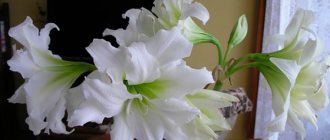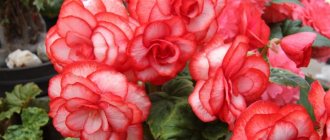Substrate
To plant the bulbs you will need a light substrate. If possible, it is better to cook it yourself. To do this, for 1 liter of soil mixture you need to take 2 parts of leaf soil, 1 part of coarse sand and 2 teaspoons of superphosphate. Phosphorus is necessary for the plant to bloom brightly and spectacularly. Add half a teaspoon of dolomite flour and 2 teaspoons of ash. Mix everything thoroughly.
If it is not possible to make the substrate yourself, you can take ready-made soil for flowering plants.
Preparing amaryllis for the dormant period
The dormant period for amaryllis is the end of autumn and the beginning of winter. For hippeastrums, the dormant period begins after the plant has flowered, because hippeastrums can be driven out at any time of the year, and not just at the end of summer or early autumn. Early forcing in autumn or late is possible - then the hippeastrum blooms at the end of winter or beginning of spring. Some varieties bloom even in summer.
But whenever your amaryllis or hippeastrum blooms, it needs a period of rest. So far, only one evergreen species of hippeastrum is known - Hippeastrum Papilio, for which there is no need for a dormant period. The remaining varieties of amaryllis and hippeastrum should rest. If you planted amaryllis or hippeastrum in the ground for the summer, then you need to dig its bulb out of the ground before frost and store it in a cool, dark, dry place.
- Violets: how to get many cuttings from one leaf
Bulb
It is recommended to prepare the bulbs for planting at the end of February. To do this, you need to remove all the old soil and carefully inspect the bulbs. Rotten parts, if any, should be removed if they did not fall off with the old soil. Clean the neck and bottom of old scales, this is where all the infection accumulates. We cut off dead roots; those that are too long can be shortened slightly. If you find a fungal infection, you need to treat the plant with a fungicide and then dry it for 3-4 hours.
Viable children, if they are formed, must be carefully separated and planted in separate pots.
Temperature
When at rest, amaryllis and hippeastrum bulbs should be kept in a cool room. It is best if the temperature is about 15°C, but a temperature of 10°C is also considered acceptable, and the upper value is 18°C. If it is cooler, the bulb may hurt, and if it drops below 5°C, it may die.
- Zephyranthes
Therefore, if you live in an area where the soil freezes below 5°C in winter, it is better to dig up the bulbs for the winter. This is especially true for amaryllis. A higher temperature than 18ºC during the dormant period may cause the bulb to germinate too quickly.
This is also not very good, since the plant did not have time to rest, and it is complete rest that guarantees the establishment of a healthy flower arrow.
During dormancy, you only need to water the bulb so that it does not dry out - once every month and a half. Moreover, water must be poured into the pan so that in conditions of cool air and excess water the bulb does not rot.
You will know that the recuperation period is over when a flower shoot appears on the amaryllis bulb. But active watering and fertilizing should begin only after this arrow extends to 10 cm. From this moment a new growth cycle of amaryllis or hippeastrum begins. Now you need to learn how to care for amaryllis at home and in the garden, depending on where it will grow.
Watering
Watering should be moderate until the flower shoot or a sufficient number of leaves grow. Very carefully, without pouring on the onion itself, but only along the edge of the pot, you need to water the freshly planted onion with warm, settled water.
Watering is carried out in this way only for the first time. Subsequently, twice a week, the pot is placed up to its shoulders in a bowl of water. The bulb and soil in the pot will absorb as much moisture as required.
The pots are placed on a well-lit windowsill, but the plant must be protected from direct sunlight, otherwise burns may occur. The room temperature should be moderate, from 17 to 23 ˚С.
Hippeastrum needs good lighting even after flowering, since without it the bulb and seeds in the box will not be able to fully ripen for the next planting.
Where to start caring for hippeastrum in the fall
Already from August - September the plant needs to be prepared for rest. From this time on, it is watered less often and from the beginning of autumn, watering and fertilizing are completely stopped for 1 month. During this time, the leaves will naturally begin to wither and turn yellow.
To be able to better build up the root mass, after flowering the stems need to be cut off and seed pods should not be allowed to form. In the summer, after the flowers have withered, you can apply phosphorus-potassium fertilizer. This will strengthen the bulb.
Autumn plant care includes the following manipulations:
- Excavation of hippeastrum.
- Leaf trimming.
- Cleaning each onion.
- Treatment for disease prevention.
- Drying the bulbs in the room.
- Cleaning for storage.
Let's look at all the stages in more detail.
Digging up hippeastrum in preparation for winter
Home care for this tropical plant should include cleaning up for storage after the long flowering season has ended. In nature, there are also ever-flowering representatives of amaryllis, but almost all varieties that we sell need a period of rest for some time in order to accumulate strength and recover.
If a flower grew in the open ground in a flower bed in summer and bloomed again, it should be given more time to prepare for hibernation. You need to wait until the leaves fade on their own.
Dig up bulbs after frost - closer to November.
Indoor flowerpots will need to be sent to winter on their own and you will need to start preparing for this in August, reducing watering. After the soil in the pot dries out, a month after the cessation of moisture, the flower is removed from it and cleaned of soil.
Pruning hippeastrum before wintering
Yellowed leaves on the bulbs need to be cut off at a height of 2 - 3 cm. If it is necessary to adjust the time for forcing the plant, you can begin to retire it earlier. To do this, it is possible to trim leaves that are still green.
Important! The longer the foliage remains on the bulb, the more nutrients will go to the root. It is better to let the leaves wither on their own.
Bulb stripping
After trimming the leaves, you need to remove the roots. The bottom is cleaned completely, cutting off the roots with a sharp knife. The top layer of scales must also be removed. This will help get rid of the soil and any pests or microbes that have settled there. After peeling, you should be left with a white, clean onion.
Treatment for diseases
Already cleaned hippeastrum bulbs need to be placed in a solution of preparations for disinfection. To prevent or treat pest damage, use insecticides. A solution of “Aktara” and “Beetle eater” will help against the most common enemy of hippeastrum - mealybugs - 4 ml and 3 mg of each, respectively, per 5 liters of water. Dilute each separately and then mix together - you get 10 liters.
Dip the bulbs into the resulting solution and leave in it for a couple of minutes. The liquid will saturate them and destroy microorganisms that have penetrated between the scales.
After this, immerse the bulbs in a fungicide solution to prevent the appearance of mold and rot during storage. For example, “Maxim” is suitable, dilute 4 mg in 2 liters of water.
Drying
After processing, the bulbs can be laid out on newspaper and left indoors to dry for a couple of days. They must be completely dry before storing.
Laying hippeastrum for wintering
Dried bulbs must be stored in a cool, dry, dark place for 3 months. at this time.
To prevent the bulbs from drying out, they can be put in a box and sprinkled with dry sawdust, covered and placed in a room with a temperature of 10 - 15 degrees. Humidity should be at 50 - 60%, but not more than 80%. If the temperature is below +5, the bulbs will be damaged, if above 18, they will wake up faster and release the stem.
During storage, the hippeastrum needs to be checked periodically; as soon as the leaves appear, it is planted in a pot slightly larger in size than an onion, and they begin to water it. Young plants overwinter in a pot with soil, which can be watered once per winter. Place it away from windows and radiators.
As you can see, caring for hippeastrum in the fall is not difficult, but it is very necessary for the plant to lay a strong flower bud and bloom well the next year.
Reasons why a bulb may lose its roots
If you just purchased an onion, especially a varietal one, it is not surprising that it is in this condition. In flower shops, hippeastrum planting material is usually sold this way. Having brought it home, all that remains is to create conditions for growing roots.
In “domestic” amaryllis plants that are already growing in pots, the roots may disappear after rest or as a result of illness. Moreover, it is difficult to notice, because for a long time the plant continues to produce leaves and even bloom without roots. But over time, the supply of nutrients in the bulb is depleted. It does not receive new nutrition and the plant may die, especially from a fungus. But if you remove the lesions, everything will work out.
The best snow-white varieties: description and photo
There are several unusual varieties of snow-white hippeastrum. They all differ in the following ways :
- height;
- number of flowers in a peduncle;
- bulb diameter;
- shape and color of petals;
- throat color.
Large-flowered Alfresco
Hippeastrum Hippeastrum Alfresco (Alfresco) is a large-flowered plant variety with a height of 35 to 45 cm. It has the following distinctive features :
- The peduncle consists of 4-5 large flowers that look drooping;
- double flowers with white petals and a greenish core, diameter up to 15 cm;
- green linear leaves have graceful arched contours;
- bulbs with a diameter of 20 to 22 cm.
Important! Some petals may be colored a pleasant white-cream shade.
Picoti
The Picotee white variety, with a height of 45 to 48 cm, was registered in Holland in 1958. Has the following features :
- large flowers (diameter 15-16 cm) with soft white petals and a contrasting bright scarlet edging, noticeable even at the budding stage (in insufficient lighting, the color of the edging can vary to pale red);
- the edges of the not too wide, curved petals are wavy, there may be small red blotches at the tips;
- throat light green;
- stamen filaments are snow-white, greenish closer to the base;
- The bulbs are small, up to 10.5 cm in diameter with two peduncles.
Important! The variety is characterized by slow growth and development. The leaves appear simultaneously with the flower arrow.
Unusual terry variety Harlequin
Hippeastrum Harlequin (Harlequin), about half a meter high, is considered one of the most unusual terry varieties. It can be distinguished by the following characteristics :
- on the peduncle there are 4 flowers with a diameter of about 14 cm;
- pointed and slightly narrowed petals with wavy edges are painted snow-white;
- there is a pink-red edging;
- throat – light green;
- The bulbs are small (diameter up to 6 cm) with two peduncles.
Terry variety Arctic Nymphs
The Arctic Nymph variety reaches a height of one and a half meters to 70 cm. Main features :
- large double flowers collected in inflorescences on the flower arrow;
- wide petals are snow-white with a pinkish-pearl tint;
- the edges are wavy;
- throat greenish.
The Snow Queen
Ice Queen:
- terry variety with large white-cream flowers;
- long and not very wide petals with corrugated edges are pointed at the tips;
- throat is green.
White Peacock
White Peacock:
- on the peduncles there are from 4 to 6 snow-white flowers with a diameter of up to 22 cm;
- the height of the arrow does not exceed 30 cm;
- petals are oval with wavy edges;
- throat light yellow;
- stamen filaments are poorly developed.
Reproduction
Hippeastrum is propagated by daughter bulbs - children. In December - January, the mother bulb usually produces 1-2 additional bulbs. Small bulbs are separated from the mother bulb when they have their own roots. Small bulbs are planted in small pots and grown without a dormant period for about 3 years.
Hippeastrum can be propagated by seeds. Such plants do not repeat the varietal characteristics of the mother plant, but can produce interesting and new hybrids. You can pollinate different varieties and create your own hybrids, but you need to wait 3-4 years before the first flowering. Hippeastrum seeds are sown immediately after collection. Hippeastrums obtained from seeds are grown for 3 years without a dormant period.
Hippeastrum: flowering
So, you have a blooming hippeastrum in a pot . Caring for a plant that is gaining buds or is already flowering is very simple. Keep the hippeastrum in a bright place at room temperature (not higher than 20°C), away from a heating source, periodically turning the pot with different sides towards the light. This is necessary so that the long peduncles with hippeastrum flowers grow straight. Be careful when turning the plant over. : Hippeastrum in a pot easily loses balance due to its heavy and long flower stalks. Water the hippeastrum , avoiding stagnation of water in the pots.
When the hippeastrum begins to bloom , move the pot to a cooler place (15–18°C). Lower temperatures will extend the flowering period of hippeastrum .
Hippeastrum (amaryllis). Buds, beginning of flowering
Hippeastrum (amaryllis) at home
Hippeastrum (amaryllis): home care
Use for bouquets
Hippeastrum flowers are cut off when the first buds of the inflorescence have visible color, but have not yet opened. Immediately after a short cooling at a temperature of 8-10 degrees. The inflorescences are wrapped in thin paper, then packed in cardboard boxes with a soft lining of 12, 15, 18 pieces.
Flowers that need to be stored are placed in a refrigerator in water at 10-12 °C or without water at 8-10 °C, but only for 2-3 days. At lower temperatures the flowers turn blue. The shoots break easily in water (since they are hollow inside), so after sorting, producers often wrap them with waterproof adhesive tape. Otherwise, cracked shoots must be greatly shortened before selling.











